window Lexus GS F 2016 Owner's Guide
[x] Cancel search | Manufacturer: LEXUS, Model Year: 2016, Model line: GS F, Model: Lexus GS F 2016Pages: 628, PDF Size: 8.83 MB
Page 381 of 628
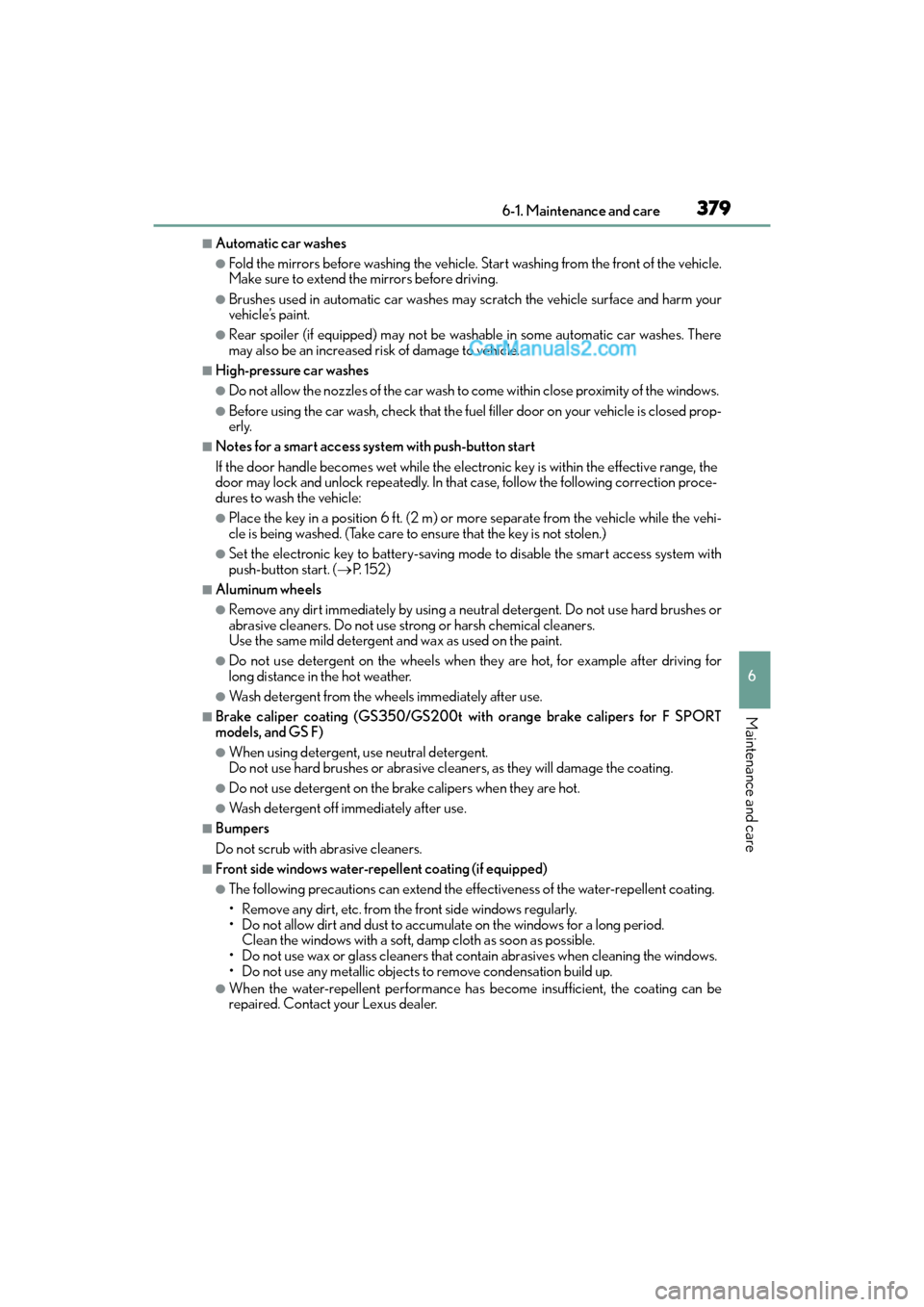
GS350_200t_GS F_OM_OM30E86U_(U)
3796-1. Maintenance and care
6
Maintenance and care
■Automatic car washes
●Fold the mirrors before washing the vehicle. Start washing from the front of the vehicle.
Make sure to extend the mirrors before driving.
●Brushes used in automatic car washes may scratch the vehicle surface and harm your
vehicle’s paint.
●Rear spoiler (if equipped) may not be washable in some automatic car washes. There
may also be an increased risk of damage to vehicle.
■High-pressure car washes
●Do not allow the nozzles of the car wash to come within close proximity of the windows.
●Before using the car wash, check that the fuel filler door on your vehicle is closed prop-
erly.
■Notes for a smart access system with push-button start
If the door handle becomes wet while the electronic key is within the effective range, the
door may lock and unlock repeatedly. In that case, follow the following correction proce-
dures to wash the vehicle:
●Place the key in a position 6 ft. (2 m) or more separate from the vehicle while the vehi-
cle is being washed. (Take care to ensure that the key is not stolen.)
●Set the electronic key to battery-saving mode to disable the smart access system with
push-button start. ( →P. 1 5 2 )
■Aluminum wheels
●Remove any dirt immediately by using a neutral detergent. Do not use hard brushes or
abrasive cleaners. Do not use strong or harsh chemical cleaners.
Use the same mild detergent and wax as used on the paint.
●Do not use detergent on the wheels when they are hot, for example after driving for
long distance in the hot weather.
●Wash detergent from the wheels immediately after use.
■Brake caliper coating (GS350/GS200t with orange brake calipers for F SPORT
models, and GS F)
●When using detergent, use neutral detergent.
Do not use hard brushes or abrasive cl eaners, as they will damage the coating.
●Do not use detergent on the brake calipers when they are hot.
●Wash detergent off immediately after use.
■Bumpers
Do not scrub with abrasive cleaners.
■Front side windows water-repellent coating (if equipped)
●The following precautions can extend the effectiveness of the water-repellent coating.
• Remove any dirt, etc. from the front side windows regularly.
• Do not allow dirt and dust to accumulate on the windows for a long period.
Clean the windows with a soft, damp cloth as soon as possible.
• Do not use wax or glass cleaners that contain abrasives when cleaning the windows.
• Do not use any metallic objects to remove condensation build up.
●When the water-repellent performance has become insufficient, the coating can be
repaired. Contact your Lexus dealer.
Page 386 of 628

384
GS350_200t_GS F_OM_OM30E86U_(U)6-1. Maintenance and care
NOTICE
■Cleaning detergents
●Do not use the following types of detergent, as they may discolor the vehicle interior
or cause streaks or damage to painted surfaces:
• Non-seat portions: Organic substances su
ch as benzene or gasoline, alkaline or
acidic solutions, dye, and bleach
• Seats: Alkaline or acidic solutions, such as thinner, benzene, and alcohol
●Do not use polish wax or polish cleaner. The instrument panel’s or other interior part’s
painted surface may be damaged.
■Preventing damage to leather surfaces
Observe the following precautions to avoid damage to and deterioration of leather
surfaces:
●Remove any dust or dirt from leather surfaces immediately.
●Do not expose the vehicle to direct sunlight for extended periods of time. Park the
vehicle in the shade, especially during summer.
●Do not place items made of vinyl, plastic, or containing wax on the upholstery, as they
may stick to the leather surface if the vehicle interior heats up significantly.
■Water on the floor
Do not wash the vehicle floor with water.
Vehicle systems such as the audio system may be damaged if water comes into contact
with electrical components such as the audio system above or under the floor of the
vehicle. Water may also cause the body to rust.
■When cleaning the inside of the windshield (vehicles with Lexus Safety System+)
Do not allow glass cleaner to contact the lens. Also, do not touch the lens. ( →P. 2 3 3 )
■Cleaning the inside of the rear window
●Do not use glass cleaner to clean the rear window, as this may cause damage to the
rear window defogger heater wires or antenna. Use a cloth dampened with luke-
warm water to gently wipe the window clean. Wipe the window in strokes running
parallel to the heater wires or antenna.
●Be careful not to scratch or damage the heater wires or antenna.
Page 420 of 628
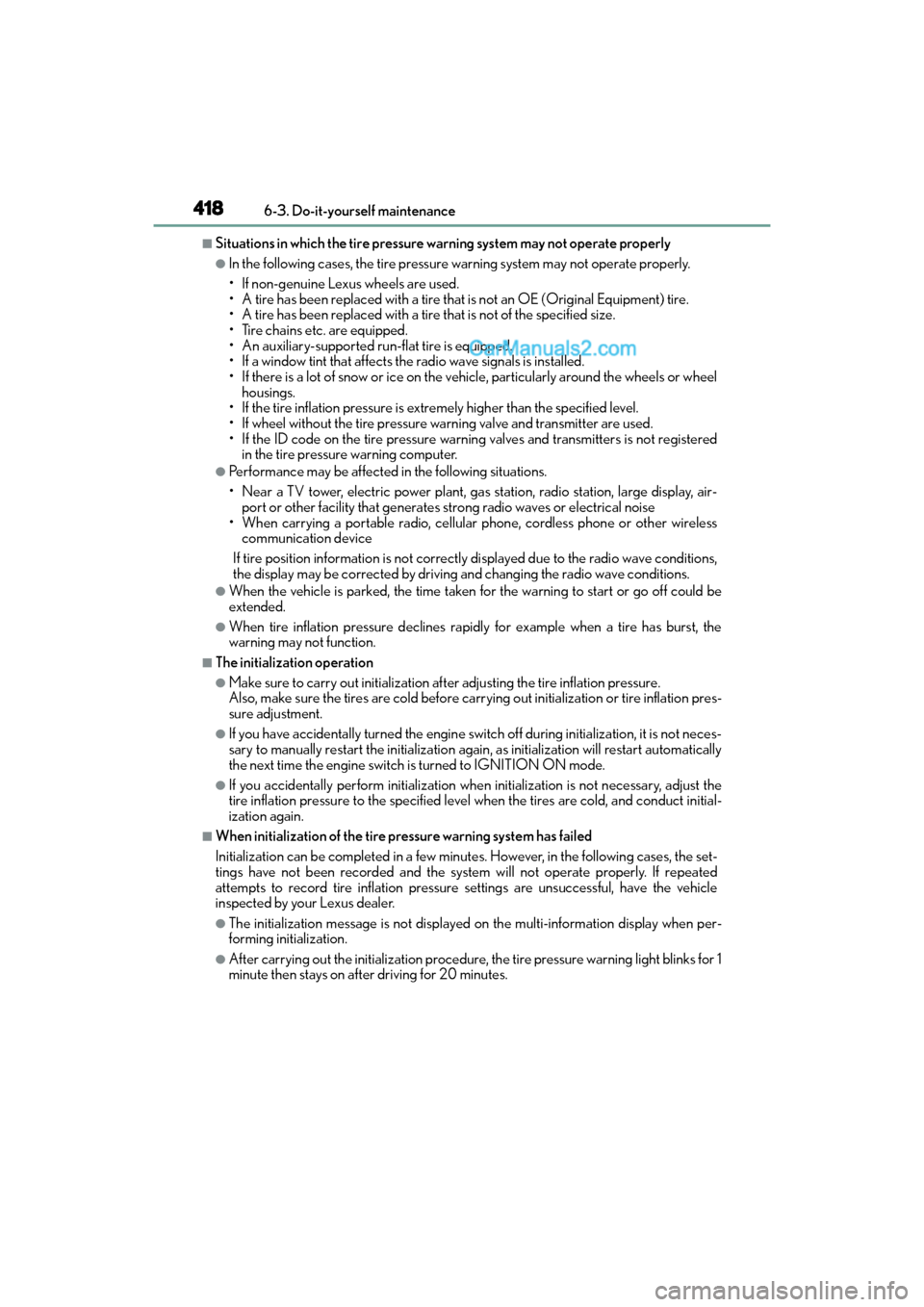
418
GS350_200t_GS F_OM_OM30E86U_(U)6-3. Do-it-yourself maintenance
■Situations in which the tire pressure warning system may not operate properly
●In the following cases, the tire pressure warning system may not operate properly.
• If non-genuine Lexus wheels are used.
• A tire has been replaced with a tire that is not an OE (Original Equipment) tire.
• A tire has been replaced with a tire that is not of the specified size.
• Tire chains etc. are equipped.
• An auxiliary-supported run-flat tire is equipped.
• If a window tint that affects the radio wave signals is installed.
• If there is a lot of snow or ice on the vehicle, particularly around the wheels or wheel
housings.
• If the tire inflation pressure is extremely higher than the specified level.
• If wheel without the tire pressure warning valve and transmitter are used.
• If the ID code on the tire pressure warning valves and transmitters is not registered in the tire pressure warning computer.
●Performance may be affected in the following situations.
• Near a TV tower, electric power plant, gas station, radio station, large display, air-port or other facility that generates st rong radio waves or electrical noise
• When carrying a portable radio, cellular phone, cordless phone or other wireless communication device
If tire position information is not correctl y displayed due to the radio wave conditions,
the display may be corrected by driving and changing the radio wave conditions.
●When the vehicle is parked, the time taken for the warning to start or go off could be
extended.
●When tire inflation pressure declines rapidly for example when a tire has burst, the
warning may not function.
■The initialization operation
●Make sure to carry out initialization af ter adjusting the tire inflation pressure.
Also, make sure the tires are cold before carrying out initialization or tire inflation pres-
sure adjustment.
●If you have accidentally turned the engine switch off during initialization, it is not neces-
sary to manually restart the initialization again, as initialization will restart automatically
the next time the engine switch is turned to IGNITION ON mode.
●If you accidentally perform initialization when initialization is not necessary, adjust the
tire inflation pressure to the specified leve l when the tires are cold, and conduct initial-
ization again.
■When initialization of the tire pressure warning system has failed
Initialization can be completed in a few minute s. However, in the following cases, the set-
tings have not been recorded and the syst em will not operate properly. If repeated
attempts to record tire inflation pressure settings are unsuccessful, have the vehicle
inspected by your Lexus dealer.
●The initialization mess age is not displayed on the multi-information display when per-
forming initialization.
●After carrying out the initialization procedure, the tire pressure warning light blinks for 1
minute then stays on after driving for 20 minutes.
Page 477 of 628
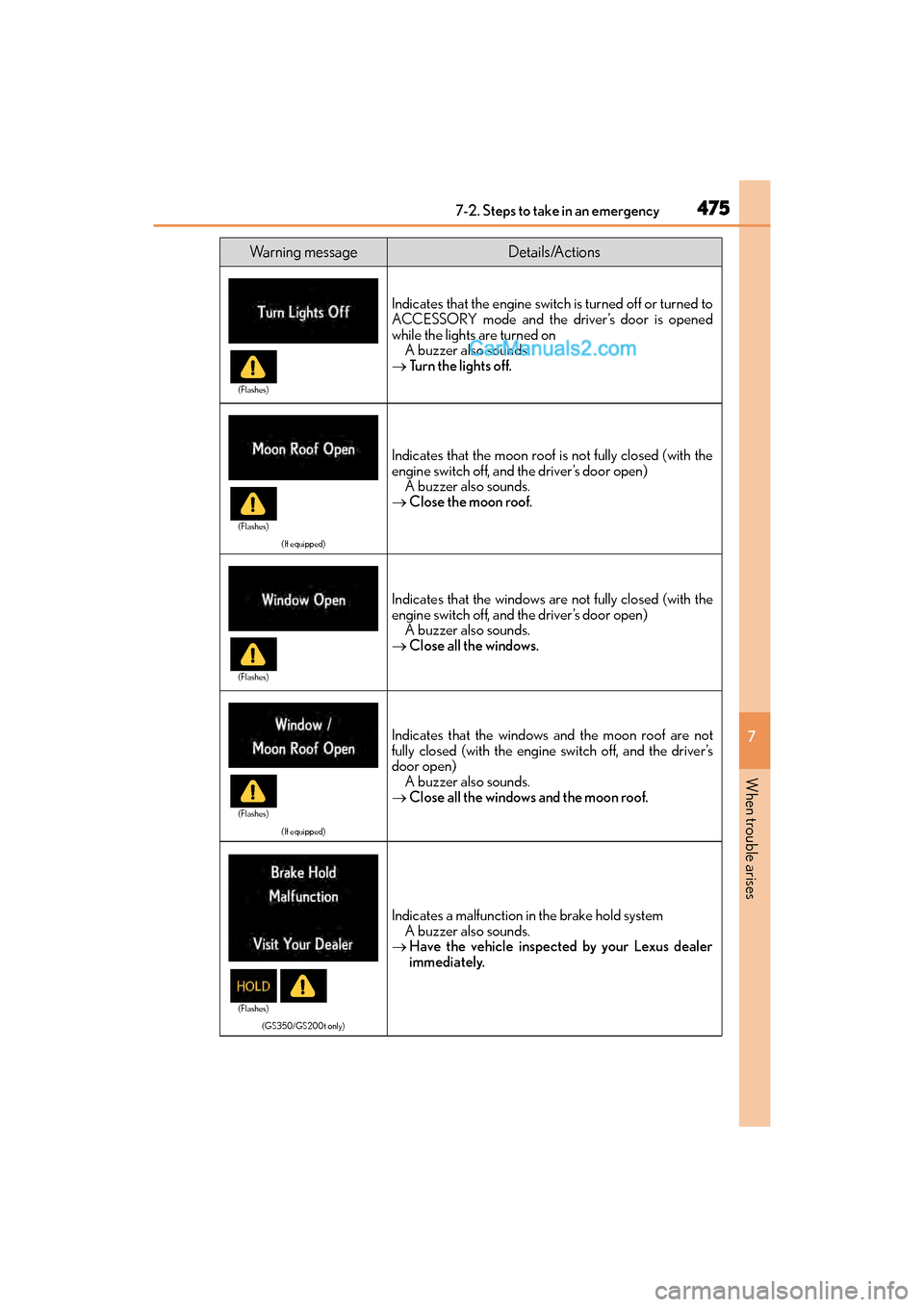
4757-2. Steps to take in an emergency
GS350_200t_GS F_OM_OM30E86U_(U)
7
When trouble arises
Indicates that the engine switch is turned off or turned to
ACCESSORY mode and the driver’s door is opened
while the lights are turned on A buzzer also sounds.
→ Turn the lights off.
(If equipped)
Indicates that the moon roof is not fully closed (with the
engine switch off, and the driver’s door open) A buzzer also sounds.
→ Close the moon roof.
Indicates that the windows are not fully closed (with the
engine switch off, and the driver’s door open)
A buzzer also sounds.
→ Close all the windows.
(If equipped)
Indicates that the windows and the moon roof are not
fully closed (with the engine switch off, and the driver’s
door open) A buzzer also sounds.
→ Close all the windows and the moon roof.
(GS350/GS200t only)
Indicates a malfunction in the brake hold system
A buzzer also sounds.
→ Have the vehicle inspected by your Lexus dealer
immediately.
Warning messageDetails/Actions
(Flashes)
(Flashes)
(Flashes)
(Flashes)
(Flashes)
Page 522 of 628
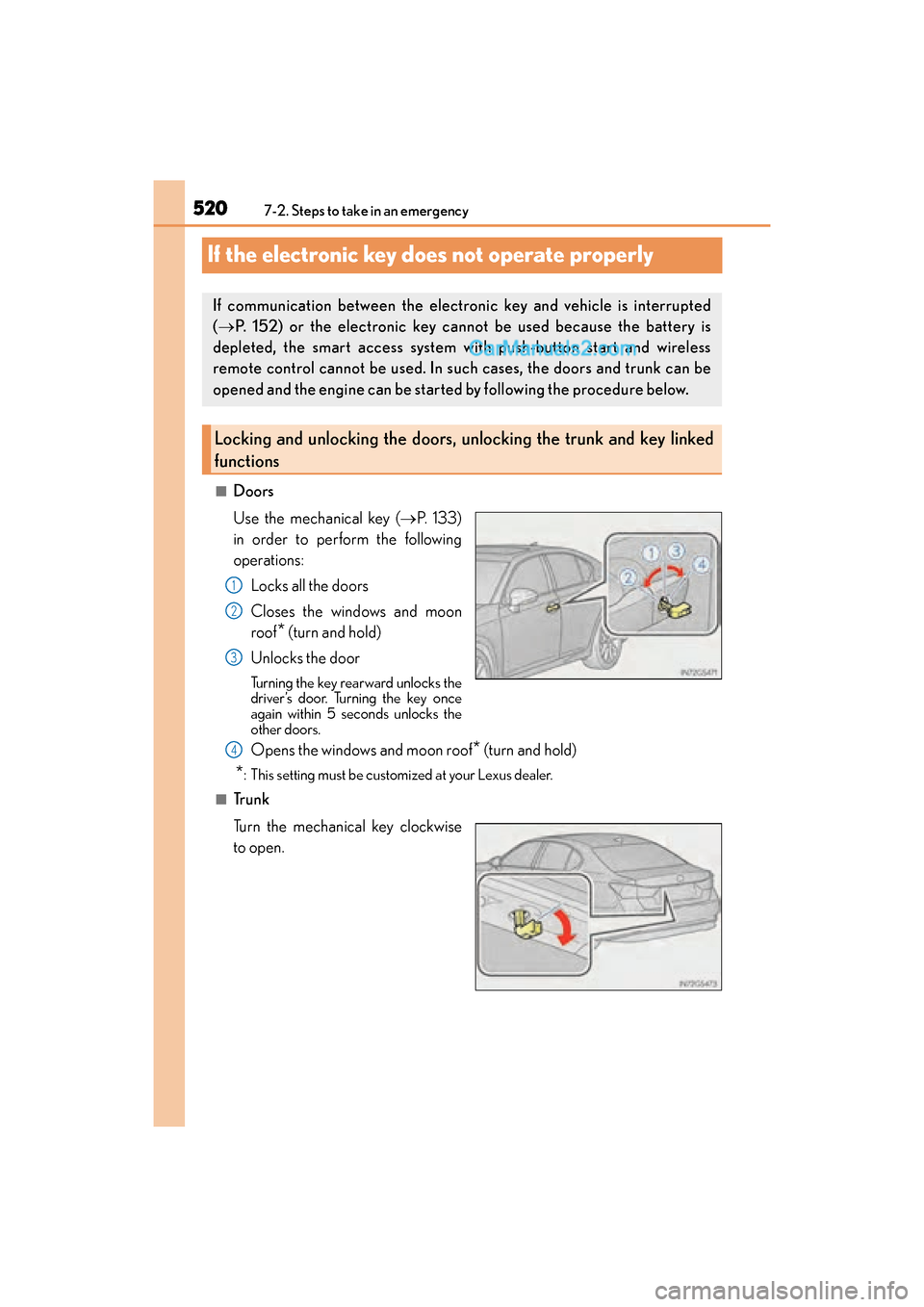
520
GS350_200t_GS F_OM_OM30E86U_(U)7-2. Steps to take in an emergency
If the electronic key does not operate properly
■Doors
Use the mechanical key (
→P. 1 3 3 )
in order to perform the following
operations:
Locks all the doors
Closes the windows and moon
roof
* (turn and hold)
Unlocks the door
Turning the key rearward unlocks the
driver’s door. Turning the key once
again within 5 seconds unlocks the
other doors.
Opens the windows and moon roof* (turn and hold)
*: This setting must be customized at your Lexus dealer.
■Tr u n k
Turn the mechanical key clockwise
to open.
If communication between the electronic key and vehicle is interrupted
( → P. 152) or the electronic key cannot be used because the battery is
depleted, the smart access system with push-button start and wireless
remote control cannot be used. In such cases, the doors and trunk can be
opened and the engine can be started by following the procedure below.
Locking and unlocking the doors, unlocking the trunk and key linked
functions
1
2
3
4
Page 524 of 628

5227-2. Steps to take in an emergency
GS350_200t_GS F_OM_OM30E86U_(U)
■Stopping the engine
Shift the shift lever to P and press the engine switch as you normally do when stopping
the engine.
■Replacing the key battery
As the above procedure is a temporary measure, it is recommended that the electronic
key battery be replaced immediately when the battery is depleted. (→P. 4 2 9 )
■Changing engine switch modes
Release the brake pedal and press the engine switch in step above.
The engine does not start and modes w ill be changed each time the switch is
pressed.( →P. 1 9 8 )
■When the electronic key does not work properly
●Make sure that the smart access system with push-button start has not been deacti-
vated in the customization setting. If it is off, turn the function on.
(Customizable features: →P. 5 6 8 )
●Check if battery-saving mode is set. If it is set, cancel the function. (→P. 151)
WA R N I N G
■When using the mechanical key and operating the power windows or moon roof
Operate the power window or moon roof after checking to make sure that there is no
possibility of any passenger having any of their body parts caught in the window or
moon roof.
Also, do not allow children to operate the mech anical key. It is possible for children and
other passengers to get caught in the power window or moon roof.
3
Page 565 of 628
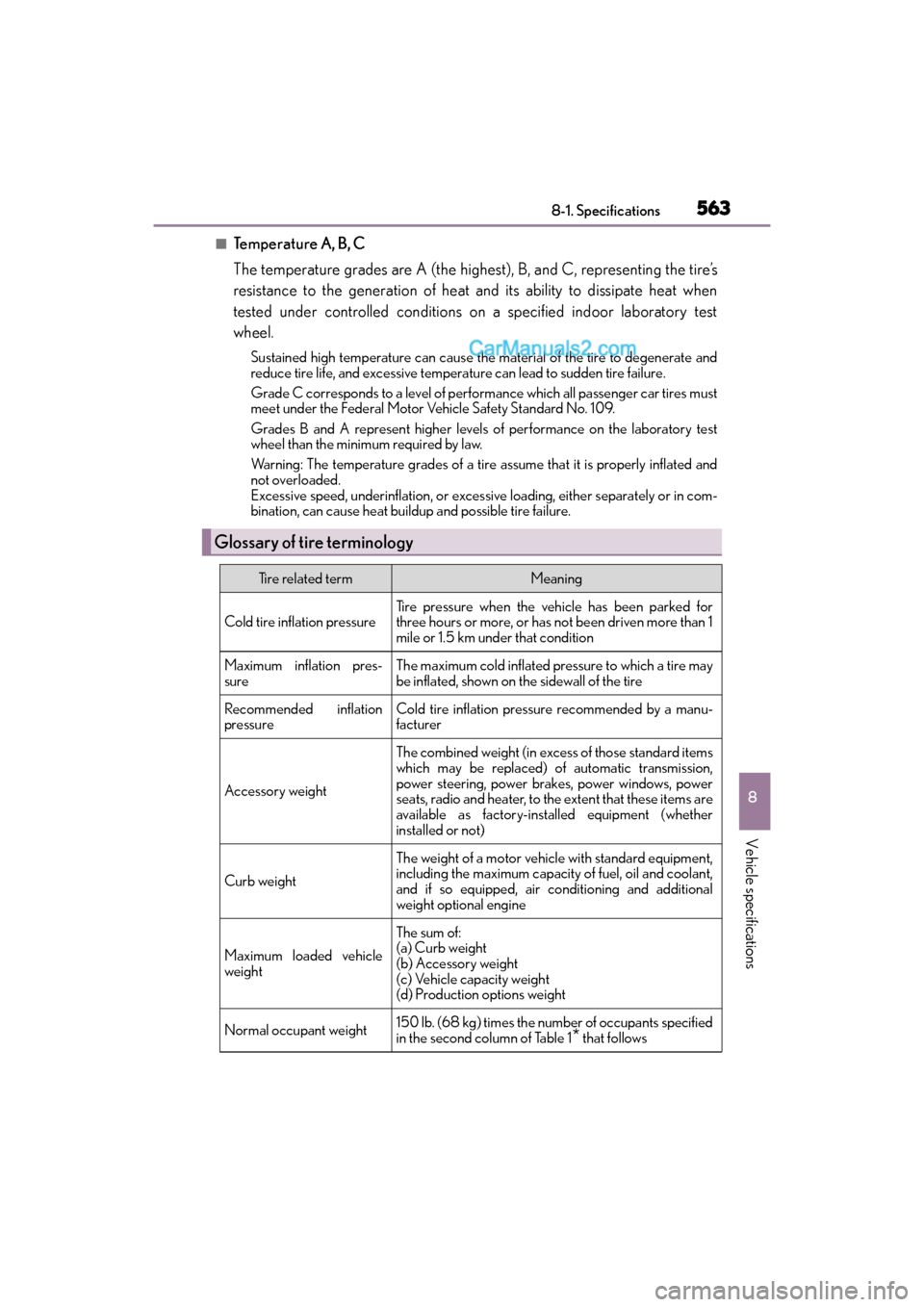
GS350_200t_GS F_OM_OM30E86U_(U)
5638-1. Specifications
8
Vehicle specifications
■Temperature A, B, C
The temperature grades are A (the highest), B, and C, representing the tire’s
resistance to the generation of heat and its ability to dissipate heat when
tested under controlled conditions on a specified indoor laboratory test
wheel.
Sustained high temperature can cause the material of the tire to degenerate and
reduce tire life, and excessive temperature can lead to sudden tire failure.
Grade C corresponds to a level of performance which all passenger car tires must
meet under the Federal Motor Vehicle Safety Standard No. 109.
Grades B and A represent higher levels of performance on the laboratory test
wheel than the minimum required by law.
Warning: The temperature grades of a tire assume that it is properly inflated and
not overloaded.
Excessive speed, underinflation, or excessive loading, either separately or in com-
bination, can cause heat buildup and possible tire failure.
Glossary of tire terminology
Tire related termMeaning
Cold tire inflation pressureTire pressure when the vehicle has been parked for
three hours or more, or has not been driven more than 1
mile or 1.5 km under that condition
Maximum inflation pres-
sureThe maximum cold inflated pressure to which a tire may
be inflated, shown on the sidewall of the tire
Recommended inflation
pressureCold tire inflation pressure recommended by a manu-
facturer
Accessory weight
The combined weight (in excess of those standard items
which may be replaced) of automatic transmission,
power steering, power brakes, power windows, power
seats, radio and heater, to the extent that these items are
available as factory-installed equipment (whether
installed or not)
Curb weight
The weight of a motor vehicle with standard equipment,
including the maximum capacity of fuel, oil and coolant,
and if so equipped, air conditioning and additional
weight optional engine
Maximum loaded vehicle
weight
The sum of:
(a) Curb weight
(b) Accessory weight
(c) Vehicle capacity weight
(d) Production options weight
Normal occupant weight150 lb. (68 kg) times the number of occupants specified
in the second column of Table 1
* that follows
Page 579 of 628

GS350_200t_GS F_OM_OM30E86U_(U)
5778-2. Customization
8
Vehicle specifications
■Power windows and moon roof (→P. 175, 178)
■Automatic light control system ( →P. 215)
■Lights ( →P. 215)
*: U.S.A. only
FunctionDefault
settingCustomized setting
Mechanical key linked operationOffOn——O
Wireless remote control linked opera-
tionOffOn
(Open only)——O
Buzzer sounds if operated using wire-
less remote controlOnOff——O
123
FunctionDefault settingCustomized setting
Light sensor sensitivityStandard-2 to 2O—O
Time elapsed before the headlights
automatically turn off30
seconds
Off
O—O60
seconds
90
seconds
Welcome light illumination controlOnOff——O
123
FunctionDefault settingCustomized setting
Daytime running lights*OnOffO—O
123
Page 603 of 628

601What to do if... (Troubleshooting)
GS350_200t_GS F_OM_OM30E86U_(U)
●Did you press the engine switch while firmly depressing the brake pedal?
(→ P. 1 9 7 )
●Is the shift lever in P? (→ P. 199)
●Is the electronic key anywhere detectable inside the vehicle? ( →P. 1 5 0 )
●Is the steering wheel unlocked? ( →P. 199)
●Is the electronic key battery weak or depleted?
In this case, the engine can be started in a temporary way. ( →P. 5 2 1 )
●Is the battery discharged? ( →P. 5 2 3 )
●Is the engine switch in IGNITION ON mode?
If you cannot release the shift lever by depressing the brake pedal with the
engine switch in IGNITION ON mode ( →P. 5 1 7 )
●It is locked automatically to prevent theft of the vehicle. ( →P. 1 9 9 )
●Is the window lock switch pressed?
The power window except for the one at the driver’s seat cannot be operated
if the window lock switch is pressed. ( →P. 1 7 5 )
●The auto power off function will be operated if the vehicle is left in ACCES-
SORY or IGNITION ON mode (the engine is not running) for a period of
time. ( →P. 199)
If you think something is wrong
The engine does not start
The shift lever cannot be shifted fr om P even if you depress the brake
pedal
The steering wheel cannot be turned after the engine is stopped
The windows do not open or close by operating the power window
switches
The engine switch is turned off automatically
Page 608 of 628

606Alphabetical index
GS350_200t_GS F_OM_OM30E86U_(U)
Child restraint system............................ 59Booster seats, definition ....................59
Booster seats, installation.................. 67
Convertible seats, definition ............59
Convertible seats, installation .........65
Front passenger occupant
classification system ......................... 52
Infant seats, definition ..........................59
Infant seats, installation .......................65
Installing CRS
with LATCH anchors ..................... 64
Installing CRS with seat belts ..........65
Installing CRS with top tether strap .........................68
Child safety ................................................ 58 Airbag precautions .............................. 44
Battery precautions ................. 411, 527
Child restraint system .........................59
How your child should wear the seat belt ................................. 37, 38
Installing child restraints..................... 63
Moon roof precautions....................180
Power window lock switch ............ 175
Power window precautions ...........177
Rear door child-protectors ........... 140
Removed electronic key battery precautions.............. 430
Seat belt comfort guide ..................... 37
Seat belt extender precautions ......40
Seat belt precautions .......................... 62
Seat heater precautions.................. 342
Trunk precautions............................... 146 Child-protectors ....................................140
Cleaning .......................................378, 382
Aluminum wheels .............................. 379
Exterior ................................................... 378
Interior ..................................................... 382
Seat belts................................................383
Clock................................................. 87, 359
Coat hooks ............................................. 364
Condenser.............................................. 408
Console box............................................. 351
Console box light ................................... 351
Consumption screen ............................128
Cooling system ..................................... 406 Engine overheating .......................... 528
Consumption screen ............................ 127
Cruise control Cruise control .....................................290
Dynamic radar cruise control ..... 278
Dynamic radar cruise control with full-speed range ................... 266
Cup holders............................................ 352
Curtain shield airbags ............................42
Customizable features ...................... 568
Daytime running light system............ 216
Defogger Front windshield................................. 334
Outside rear view mirrors ............ 334
Rear window ........................................ 334
Differential Front differential .................................548
Rear differential................................... 549
D